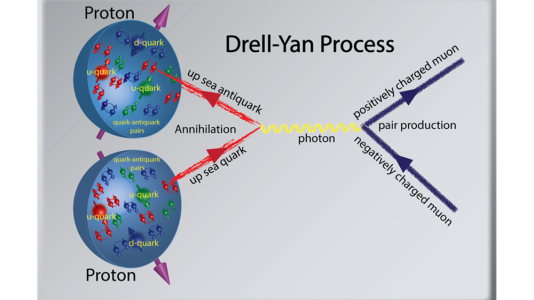
The science
The proton is a positively charged particle that exists at the center of every atom. It is a confined complex system of strongly interacting fundamental particles, quarks, and the nuclear force carriers, gluons. Its properties like charge and spin are dominated by three quarks — two “up” quarks and one “down” quark, called valence quarks, giving rise to the proton’s charge, spin, and other defining properties. However, take a closer look, and a turbulent sea of quarks and their antimatter counterparts, antiquarks, popping in and out of existence before quickly annihilating each other is ever present and remains an enigma. The SeaQuest Collaboration studied the antimatter makeup of the proton sea for a wide range of quark momenta with higher precision than ever before. They found that there are, on average, 1.4 down antiquarks for every up antiquark.
The impact
Understanding the structure of the proton can provide insight into the nature of the forces that hold it together, and these insights help physicists answer some of the most fundamental questions in all of science. The SeaQuest data agree with two of the many competing models of the proton, demonstrating the importance of the proton’s sea quarks. In addition, the SeaQuest findings will help scientists parse through data from particle collisions at the Large Hadron Collider in search of new physics.
Summary
SeaQuest researchers investigated an asymmetry between the up and down flavors of antiquarks in the proton sea. Their data show that in the proton, down antiquarks outnumber up antiquarks over a wide range of quark momenta. To probe the quarks and antiquarks in the proton, the scientists shot high-energy beams of protons at targets of liquid hydrogen and deuterium. They studied the aftermath of collisions between protons from the beam and protons in the targets. When protons collide, many things can happen. In one process, called the Drell-Yan process, their quarks and antiquarks annihilate, and two new fundamental particles called muons come out of the annihilation, acting as the interaction’s signature. By studying the signatures from the collisions, the scientists determined that down antiquarks are about 50 percent more abundant in the proton than up antiquarks, even in the rare case that a single antiquark carries more than a third of the proton’s total momentum. The origin of antimatter within the proton and the observed asymmetry can be explained by a model in which some of the antiquarks are carried within a cloud of virtual particles forming a field around the proton. This class of models make additional predictions about the spin of the antimatter in the proton that can be tested with future measurements.
Funding
This work was performed by the SeaQuest Collaboration, whose work was supported in part by U.S. Department of Energy; U.S. National Science Foundation at Mississippi State University; the JSPS (Japan) KAKENHI Tokyo Tech Global COE Program, Japan; Yamada Science Foundation of Japan; and the Ministry of Science and Technology (MOST), Taiwan. Fermilab is operated by Fermi Research Alliance, LLC under the U.S. Department of Energy.